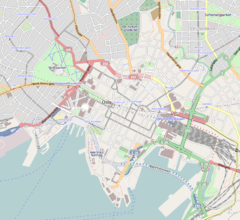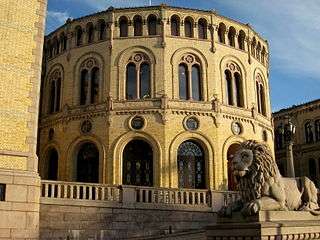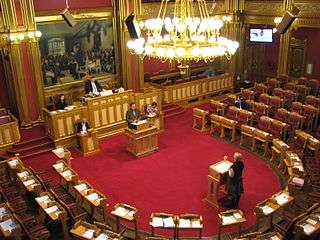Storting building
The Storting building (Norwegian: Stortingsbygningen) is the seat of the Storting, the parliament of Norway. The building is located at 22 Karl Johans gate in central Oslo, Norway. It was taken into use on 5 March 1866 and was designed by the Swedish architect Emil Victor Langlet.[1][2][3]
| Storting building | |
|---|---|
Stortingsbygningen (in Norwegian) | |
.jpg) The front of the building | |
 Location in Oslo | |
| General information | |
| Architectural style | Eclectic |
| Location | Oslo, Norway |
| Address | Karl Johans gate 22 |
| Coordinates | 59°54′47″N 10°44′24″E |
| Current tenants | Parliament of Norway |
| Construction started | 3 August 1860 |
| Inaugurated | 5 March 1866 |
| Cost | 957,332 kr |
| Design and construction | |
| Architect | Emil Victor Langlet |
History
Following the establishment of the Parliament of Norway in 1814, which had happened at a private home belonging to Carsten Anker in Eidsvoll, the newly established legislature started meeting at Christiania lærde Skole at Tollbodgaten and Dronningsgate. From 1854, the legislature started using the grand hall at the Royal Frederick University.[4] However, proposals of an own parliament building had arisen. The parliament voted down a government proposal to create such a building in 1833,[5] but in 1836, the work to establish a permanent building started. Twelve lots in central Oslo, located between the Royal Palace and Oslo East Station. The government decided to build in the Palace Park, and this was passed by the parliament. However, instead the government chose to purchase the current lot instead. This was approved by parliament in 1857.[4]
The next discussion was related to the architecture. Several proposals were made, and twelve of these have been preserved. A design competition was initiated in 1856, and this was won by the architects Heinrich Ernst Schirmer and Wilhelm von Hanno. However, the Storting decided to reject the proposal because it looked too much like a church. Instead, a proposal from the Swedish architect Emil Victor Langlet was chosen with 59 against 47 votes on 18 May 1860. Construction started on 3 August 1860, and the cornerstone was laid on 10 October 1861. The building cost 957,332 kr. The parliament moved in on 5 March 1866.[4]
Initially, the building was too large for the needs of the legislature, and several other government agencies, including the Office of the Auditor General of Norway, the National Archival Services, the Mapping and Cadastre Authority and the Director of Canals were also housed there. As the parliament has expanded, these various agencies have moved out.[4]
During the German invasion of Norway on 9 April 1940, the Storting relocated and held two meetings, once in a cinema in Hamar and once at Elverum Folk High School (Elverum folkehøgskole). The remaining meetings during World War II were held abroad. During the war, the building was taken over by the German forces, and at first used as barracks. Later, Reichskommissar Josef Terboven with administration moved into the building. The Lagting Chamber was refurnished, with the ceiling lowered and the interior redecorated with mahogany panels and funkis style.[4][6]
From 1951 to 1959, a four-story office building was built at the back of the building. The courtyard was filled in, and the chamber expanded. This work was led by architect Nils Holter (1899-1995). In 1872, parliament bought Prinsens gate 26, in 1988 they bought Akersgata 21, in 1993 Nedre Vollgate 20, in 1997 Nedre Vollgate 18 and in 1999 Tollbugaten 31. The parliament also rents offices in Akersgata 18.[7]
Architecture
The building is built in yellow brick with details and basement in light gray granite. It is a combination of several styles, including inspirations from France and Italy. A characteristic feature of Stortingsbygningen is the way the plenary chamber is located in the semi-circular section in the front of the building, as opposed to the building's centre. The back side of the building mirrors the facade of the front, with the meeting chamber of the now-abolished Lagting legislative chamber. The interior of the building is also designed by Langlet.[4]
Gallery
 The proposal by Heinrich Ernst Schirmer and Wilhelm von Hanno that won the 1856 competition, but was finally rejected
The proposal by Heinrich Ernst Schirmer and Wilhelm von Hanno that won the 1856 competition, but was finally rejected Exterior detail
Exterior detail Interior of the Plenary Chamber
Interior of the Plenary Chamber
References
| Wikimedia Commons has media related to Stortingsbygningen. |
- "Stortinget - Karl Johans gate 22". Kulturminnesøk. Retrieved November 1, 2017.
- Ole Petter Bjerkek. "Emil Victor Langlet". Norsk kunstnerleksikon. Retrieved November 1, 2017.
- Official video from the Plenary Chamber www.visitoslo.com
- Parliament of Norway. "Stortingsbygningen fra 1866 til i dag" (in Norwegian). Archived from the original on 7 October 2009. Retrieved 14 October 2009.
- Nordby, Trond (2004). I politikkens sentrum. Variasjoner i Stortingets makt 1814–2004 (in Norwegian) (2nd ed.). Oslo: Universitetsforlaget. p. 139. ISBN 82-15-00651-5.
- "Om Elverum folkehøgskole". Elverum folkehøgskole. Retrieved November 1, 2017.
- Trond Marinus Indahl. "Nils Holter, arkitekt". Norsk kunstnerleksikon. Retrieved November 1, 2017.
External links
- Storting official website
- National Archive on the building
- "Mysterious man snuck into the plenary chamber" (in Norwegian). Verdens Gang. 2012-06-22.
![]()